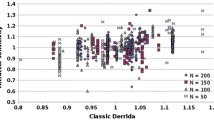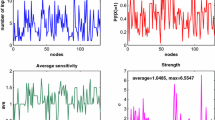Abstract
Boolean delay equations (BDEs) areevolution equations for a vector of discrete variables x(t). The value of each componentX i (t), 0 or 1. depends on previous values of all componentsx j (t− t ij ), x i (t)=f i (x1(t−t i1),...,x n (t −t in )). BDEs model the evolution of biological and physical systems with threshold behavior and nonlinear feedbacks. The delays model distinct interaction times between pairs of variables. In this paper, BDEs are studied by algebraic, analytic, and numerical methods. It is shown that solutions depend continuously on the initial data and on the delays. BDEs are classified intoconservative anddissipative. All BDEs with rational delays only haveperiodic solutions only. But conservative BDEs with rationally unrelated delays haveaperiodic solutions of increasing complexity. These solutions can be approximated arbitrarily well by periodic solutions of increasing period.Self-similarity andintermittency of aperiodic solutions is studied as a function of delay values, and certain number-theoretic questions related toresonances and diophantine approximation are raised. Period length is shown to be a lower semicontinuous function of the delays for a given BDE, and can be evaluated explicitly for linear equations. We prove that a BDE isstructurable stable if and only if it has eventually periodic solutions of bounded period, and if the length of initial transients is bounded. It is shown that, for dissipative BDEs, asymptotic solution behavior is typically governed by areduced BDE. Applications toclimate dynamics and other problems are outlined.
Similar content being viewed by others
References
F. Jacob and J. Monod,J. Molec. Biol. 3:318 (1961).
M. Sugita,J. Theor. Biol. 4:179 (1963).
S. A. Kauffman,J. Theor. Biol. 22:437 (1969).
J. von Neumann,Theory of Self-Reproducing Automata, edited and completed by A. W. Burks (University of Illinois, Urbana, 1966).
S. Ulam,Ann. Rev. Biophys. Bioeng. 1:277 (1972).
S. Wolfram,Rev. Mod. Phys. 55:583 (1983).
V. S. Černjavskii,Trudy Moskov. Mat. Obsč. 9:425 (1960); Engl. transl.Am. Math. Transl. (Series 2)39:207 (1964).
E. Fredkin and T. Toffoli,Int. J. Theor. Phys. 21:219 (1982).
R. Thomas,J. Theor. Biol. 42:563 (1973).
R. Thomas,J. Theor. Biol. 73:631 (1978).
C. Nicolis,Q. J. R. Meteorol. Soc. 108:707 (1982).
M. Ghil and J. Tavantzis,SIAM J. Appl. Math. 43:1019 (1983).
D. Dee and M. Ghil,SIAM J. Appl. Math. 44:111 (1984).
A. P. Mullhaupt,Boolean Delay Equations: A Class of Semidiscrete Dynamical Systems, Ph.D. thesis, New York University, New York (1984).
B. H. Arnold,Logic and Boolean Algebra (Prentice-Hall, Englewood Cliffs, New Jersey, 1962).
S. W. Golomb,Shift Register Sequences (Holden-Day, San Francisco, 1967).
R. B. Pearson,J. Comput. Phys. 49:478 (1983).
G. Birkhoff and S. MacLane,A Survey of Modern Algebra, 3rd ed. (Macmillan, New York, 1965).
E. Lucas,Théorie des nombres (Gauthier-Villars, Paris, 1891), p. 418.
F. Hausdorff,Math. Ann. 79:157 (1919).
L. F. Richardson,Proc. R. Soc. London Ser. A 110:709 (1926).
B. Mandelbrot,The Fractal Geometry of Nature (Freeman, San Francisco, 1982).
U. Frisch (with G. Parisi), inTurbulence and Predictability in Geophysical Fluid Dynamics and Climate Dynamics, M. Ghil, R. Benzi, and G. Parisi, eds. (North-Holland, Amsterdam, 1984), p. 84.
S. J. Willson,Discrete Appl. Math. 8:91 (1984).
G. H. Hardy and E. M. Wright,An Introduction to the Theory of Numbers, 5th ed. (Clarendon, Oxford, 1979).
V. I. Arnold,Geometrical Methods in the Theory of Ordinary Differential Equations (Springer, New York, 1983).
O. Martin, A. M. Odlyzko, and S. Wolfram, preprint (1983).
Z. Kohavi,Switching and Finite Automata Theory, 2nd ed. (McGraw-Hill, New York, 1978).
J. E. Hopcroft and J. D. Ullman,Formal Languages and their Relation to Automata (Addison-Wesley, Reading, Massachusetts, 1969).
J. Guckenheimer and P. Holmes,Nonlinear Oscillations, Dynamical Systems, and Bifurcations of Vector Fields (Springer, New York, 1983).
S. E. Newhouse, inDynamical Systems, J. Moser, ed. (Birkhäuser, Boston, 1980), Section 4.
C. Foias and R. Témam, inNonlinear Dynamics and Turbulence, G. I. Barenblatt, G. Looss, and D. D. Joseph, eds. (Pitman, Boston, 1983), p. 139.
C. E. Leith,J. Atmos. Sci. 37:958 (1980).
E. N. Lorenz,J. Atmos. Sci. 37:1685 (1980).
M. Ghil, inTurbulence and Predictability in Geophysical Fluid Dynamics and Climate Dynamics, M. Ghil, R. Benzi, and G. Parisi, eds. (North-Holland, Amsterdam, 1984), p. 347.
M. Ghil and S. Childress,Topics in Geophysical Fluid Dynamics (Springer, New York, in press, 1985).
B. Saltzman,Adv. Geophys. 25:173 (1983).
M. R. Guevara, L. Glass. M. C. Mackey, and A. Shirer,IEEE Trans. Syst. Man Cybern. 13:790 (1983).
M. Ghil,Terra Cognita 4:336 (1984).
M. Ghil, A. Mullhaupt, and P. Pestiaux, preprint.
A. P. Mullhaupt, inMathematical Problems from the Physics of Fluids, G. Gallavottiet al., eds., to appear.
P. Pestiaux, Les Fonctions de Walsh Permettent une Quantification Précise des Entrées et Sorties Associées à des Systèmes Complexes Modélisés par des Équations Booléennes, Thèse Annexe, Université Catholique de Louvain, Louvain-la-Neuve, Belgium (1984).
Author information
Authors and Affiliations
Rights and permissions
About this article
Cite this article
Ghil, M., Mullhaupt, A. Boolean delay equations. II. Periodic and aperiodic solutions. J Stat Phys 41, 125–173 (1985). https://doi.org/10.1007/BF01020607
Received:
Revised:
Issue Date:
DOI: https://doi.org/10.1007/BF01020607




